Home, Regrown
Natural disasters affect people. That’s no surprise. Many of the stories we hear after an event like Hurricane Harvey are those of human displacement and loss. They include heartrending testimonials and horrific photos of homes destroyed. They also tell of humans being exceptionally kind and generous to one other, rescuing pets and property and people themselves in any boat they can find.
Clearly, massive flooding and hurricane-force winds also affect natural areas. They uproot trees, sweep away lawns, move massive amounts of soil and drown gardens. Because plants are integral to how we identify — and identify with — the places we love, their sudden degradation can leave us feeling robbed, even lost. Instead of the familiarity of gnarled live oak branches or the orange-sherbet pop of Texas lantana, there may be emptiness, a landscape stripped of its natural character.
For those reasons (and perhaps because we work at an urban garden ourselves), we at the Wildflower Center wondered how Houston’s natural areas fared and are faring in the months after this historic storm. Are they recovering? Do people still use them?
In an effort to tell the plant side of the Hurricane Harvey story — and to acknowledge, months later, that recovery for people, plants, wildlife and the city itself is far from over — we checked in with a handful of distinct Houston green spaces and asked how they are doing now. Here’s what we found out.
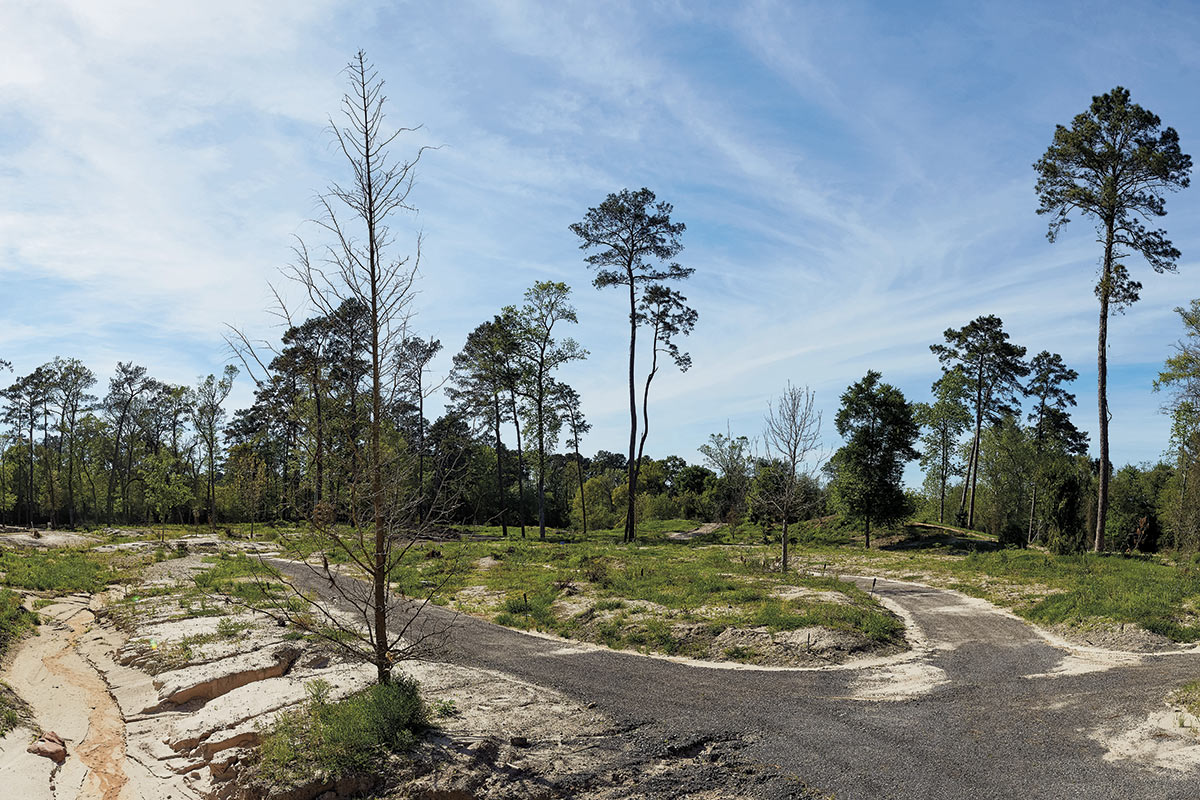
Trails emerge from the silt-swept landscape after months of shoveling and pressure washing at Mercer Botanic Gardens. PHOTO Nathan Lindstrom
THE CULTIVATED GARDEN
MERCER BOTANIC GARDENS and the Strength of Native Plants
There’s a new feature at Mercer Botanic Gardens in Humble, Texas (on the northeast side of Houston’s metro area). It’s called Silt Mountain — unofficially. The result of a massive post–Hurricane Harvey cleanup effort, it is the gardens’ deposition spot for all the silt and mud scraped from their pathways.
It looks like the ash pile from a Bunyanesque charcoal grill: a hulking gray scab on the land, a mound that, figuratively, is healing around the edges but still reminds its owner of pain. Or you’d think so. But Greenhouse Manager Jacob Martin smiles as he recounts running up the dusky pile with other garden staff to plant flags on top. “We had to make fun with some of this stuff,” he says.
“This stuff” refers to months of labor and recovery from seemingly endless damages, something Houston residents and businesses have been dealing with since late August 2017. Mercer — a free botanic garden in Harris County Precinct 4 — was still closed six months after the hurricane but partially reopened in conjunction with March Mart, their spring plant sale. Realistically, though, Martin thinks it’ll be another year for the whole site to be back to something resembling “normal.”
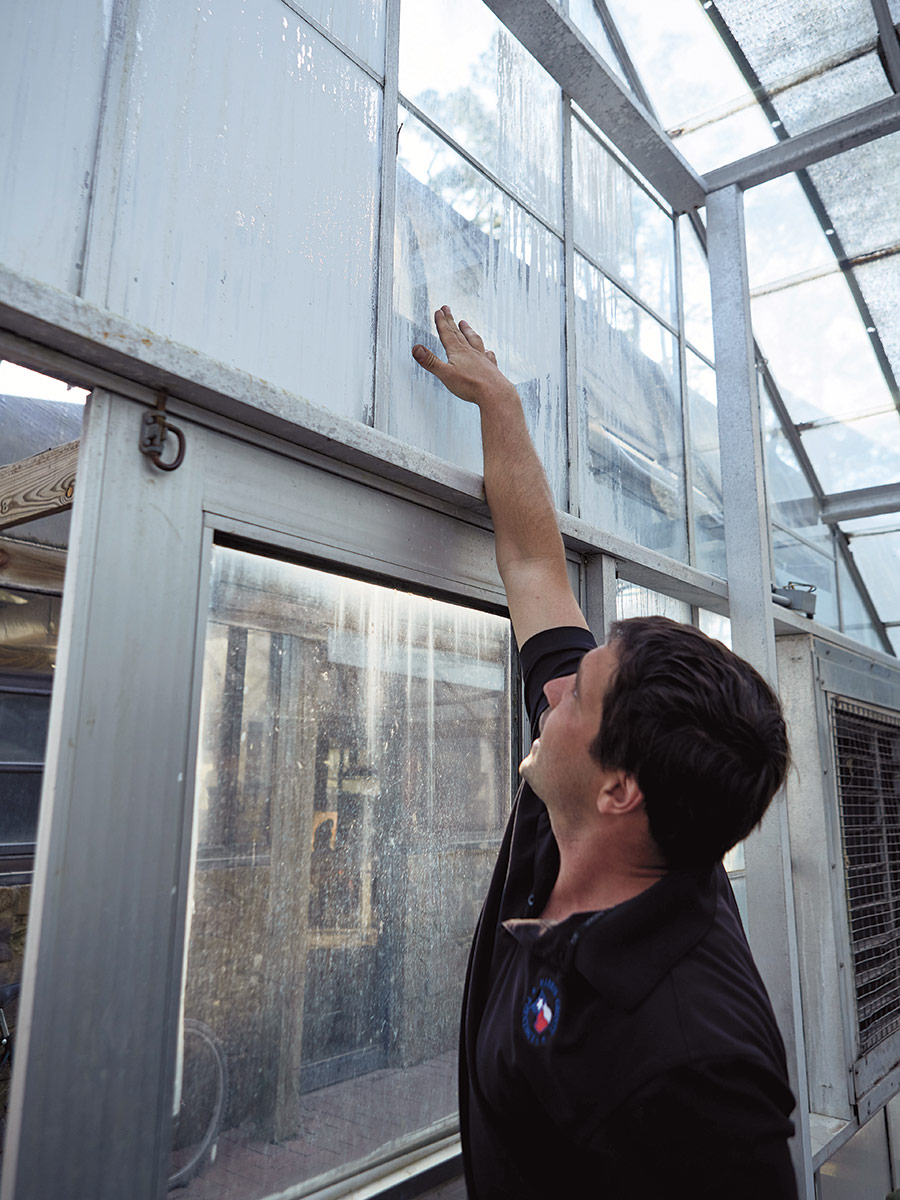
Greenhouse Manager Jacob Martin shows the post-Harvey waterline in one of Mercer’s greenhouses. PHOTO Nathan Lindstrom
Mercer’s front gardens were submerged under 8 feet of water, thanks in large part to its location along Cypress Creek. As a botanic garden with a nursery, one of Mercer’s main cleanup issues was the fact that countless plants floated out of their nursery and into the woods behind the gardens. There were (and still are) pots everywhere: in trees, on the tops of fences, scattered across the ground. Martin points out a tiny, potted Texas ebony (Ebenopsis ebano) cradled in the branches of a full-grown Texas ebony. “It floated back to its mother,” he says with a laugh. Despite his silver-lining attitude, Martin estimates that 40 percent of the nursery inventory was lost.
But, overall, he and Botanical Collections Curator Suzanne Chapman, who’s been at Mercer for 20 years, are impressed with the gardens’ toughness. “Plants [are] really resilient,” says Chapman with a little awe. “Natives are really resilient” Martin interjects, saying they gave him “a nice sense of hope.” Between them, they list aquatic milkweed (Asclepias perennis), Neches River rosemallow (Hibiscus dasycalyx), which is endemic to just a few counties in east and south Texas, and Turkscap (Malvaviscus arboreus var. drummondii) as a few native species that did just fine.
“Natives are really resilient” Martin interjects, saying they gave him “a nice sense of hope.”
Martin looks at flood recovery as “a chance to redo things, a new beginning on a lot of projects.” One of those do-overs is the chance to put native shrubbery back along the creek. Martin says they cut it down “for sun, for ornamentals,” which “played a huge part in the erosion on the banks.” Now, they plan to replant a native buffer.
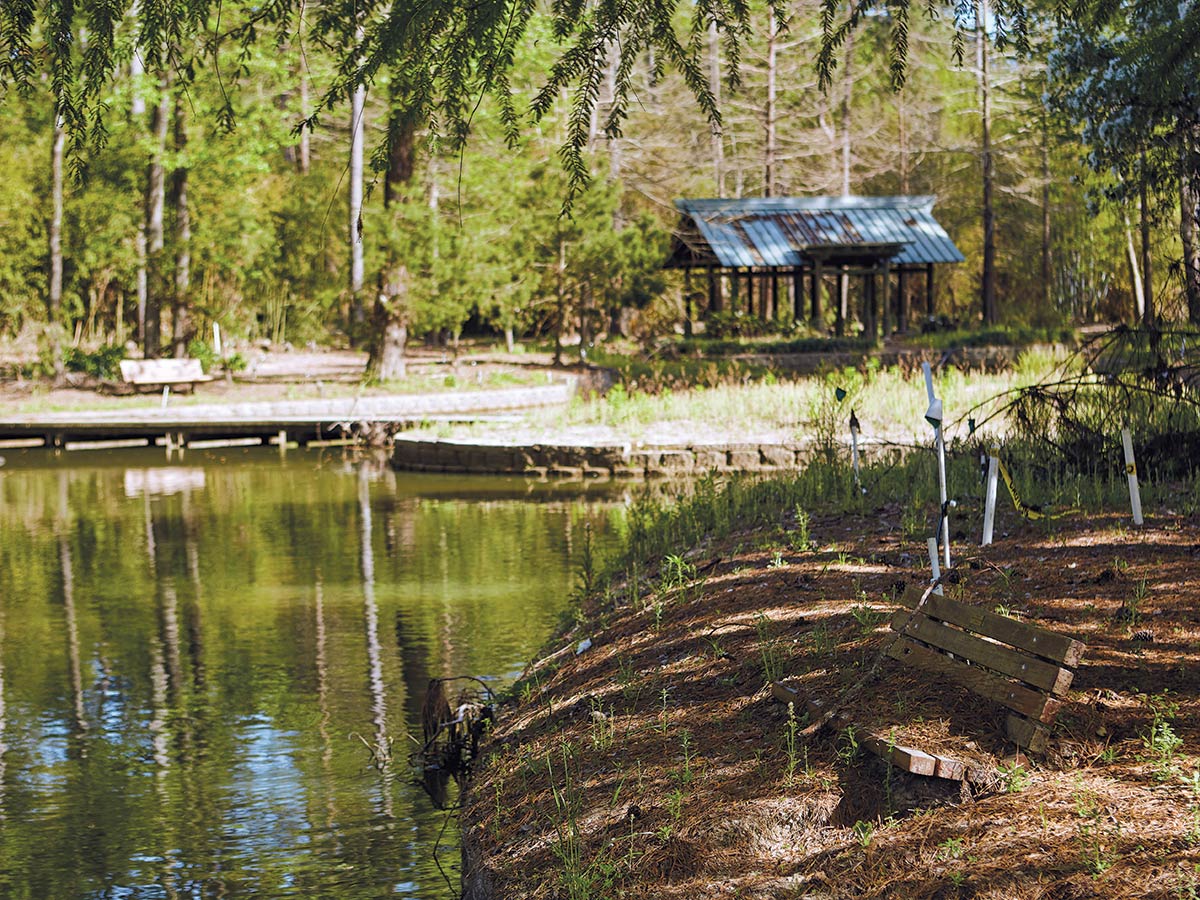
A flood-buried bench awaits future visitors at the once-popular Storey Lake. PHOTO Nathan Lindstrom
When asked about other factors that contributed to the degradation of the gardens, Chapman automatically says “increasing development.” Martin agrees: “I think they should probably just not allow [nearby, irreparably flooded] homes to be refurnished; they should buy the people out [because it’s] going to happen again,” he says, offering an alternative vision for that land: “Just expand the park.”
It’s an idea echoed by many: Perhaps these repeatedly devastated developed areas have proven unsuitable for people and buildings but could be just the place for plants.
THE COUNTY PARK
JESSE H. JONES PARK & NATURE CENTER and Landscapes Past and Future
You know how living out of a suitcase gets old after a while? Or that experience after you’ve recently moved when you can find all your shirts but not a single pair of pants? That’s sort of what the 12-person staff at Jesse H. Jones Park & Nature Center has been going through at their workplace (meaning they’re displaced, not pants-less).
The park’s Nature Center — a structure that once housed staff offices, interpretive displays and dioramas, mounted specimens of local wildlife species, a natural science library, and a permanent collection of live amphibians, fish and snakes — has been completely gutted after floodwater following Hurricane Harvey reached 78 inches high inside its walls.
At least it’s “truly an old brick-and-mortar building,” says Horticultural Coordinator Matt Abernathy, so they were able to remove all the “soft” materials (carpet, shelving, drywall, etc.) and then pressure-wash and disinfect the shell. A water line near the top of a door indicates that most people, even tall ones, would have been standing completely underwater when the water was highest. The Nature Center is set to reopen in June; in the meantime, a dozen employees are crammed into a side building, sharing three computers in what used to be a break room. (And the live animals, including an 11-foot Burmese python named “Lucky,” are being fostered by staff.)
Like Mercer Botanic Gardens, Jesse H. Jones is right next to a creek, in this case Spring Creek. “We’re no strangers to floods here,” says Abernathy. Also like Mercer, they just didn’t see the severity of Harvey coming. “The crest wasn’t forecast to be catastrophic,” he says. “We couldn’t really fathom the idea of getting more than 6 feet [in the Nature Center]. The creek was going to have to rise 30-plus feet” for that to happen. And it did. Abernathy believes a nearby flood gauge at the San Jacinto River and Highway 59 crested just shy of 70 feet, but he’s not sure because “the GPS transmission antenna [most likely] went underwater.”
In addition to damage at the Nature Center, more than 250 acres of land were underwater (roughly three-quarters of the park), resulting in erosion, sand deposition and trail impacts: “lots of sediment everywhere — sand, silt, clay, just muck,” says Abernathy.
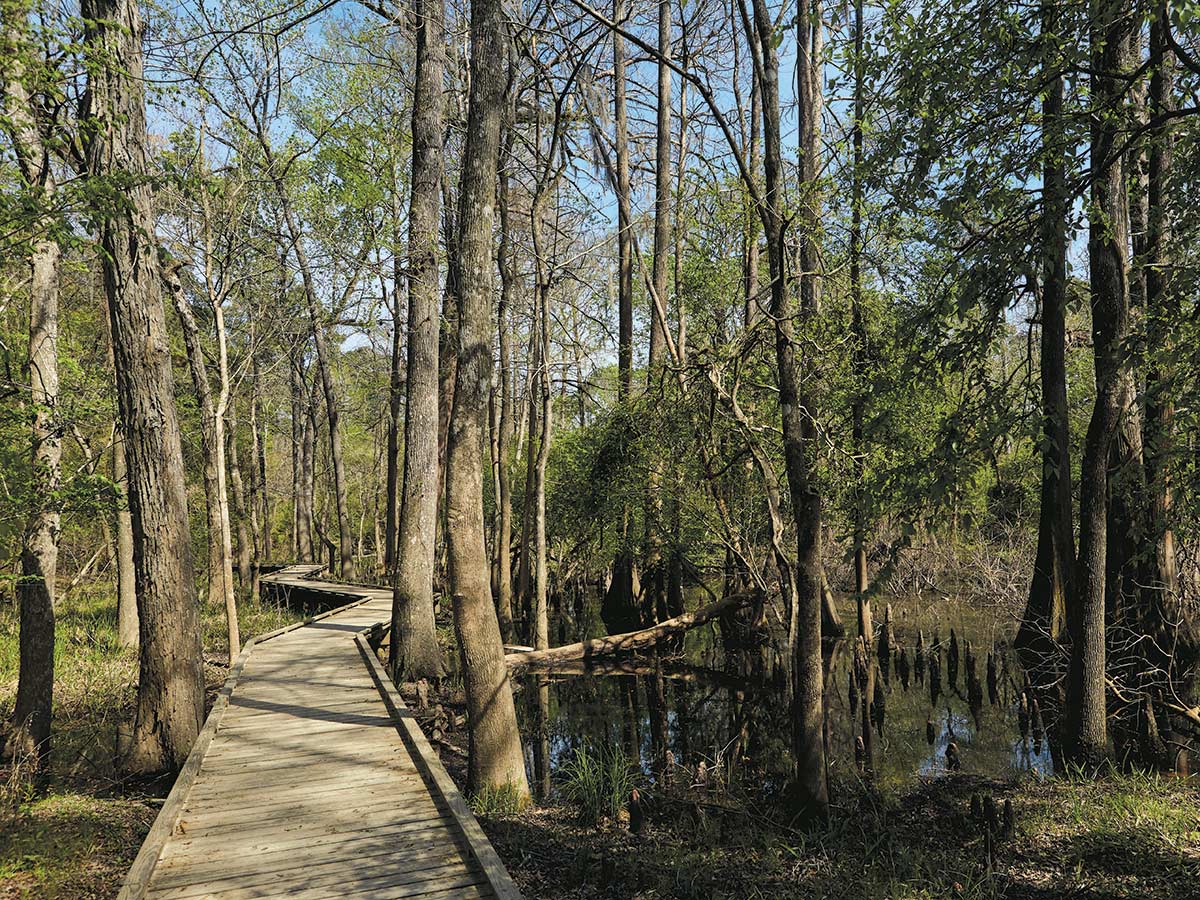
A boardwalk through one of Jesse H. Jones Park’s most resilient ecosystems, a native cypress swamp. PHOTO Nathan Lindstrom
The landscapes that fared best were historic, naturally occurring cypress ponds. “It makes perfect sense,” says Abernathy. “That’s what they were meant to do. They were meant to take on floodwater, fill up, absorb the water; those areas look the best and rebounded the quickest without any help from us.”
He credits that resilience to native species like bald cypress (Taxodium distichum), lizard’s tail (Saururus cernuus), buttonbush (Cephalanthus occidentalis) and dwarf palmetto (Sabal minor). And he’s been pleased to see bushy bluestem (Andropogon glomeratus) popping up in the forest understory in other areas of the park. It hasn’t been seeded or planted, he notes; it was just there.
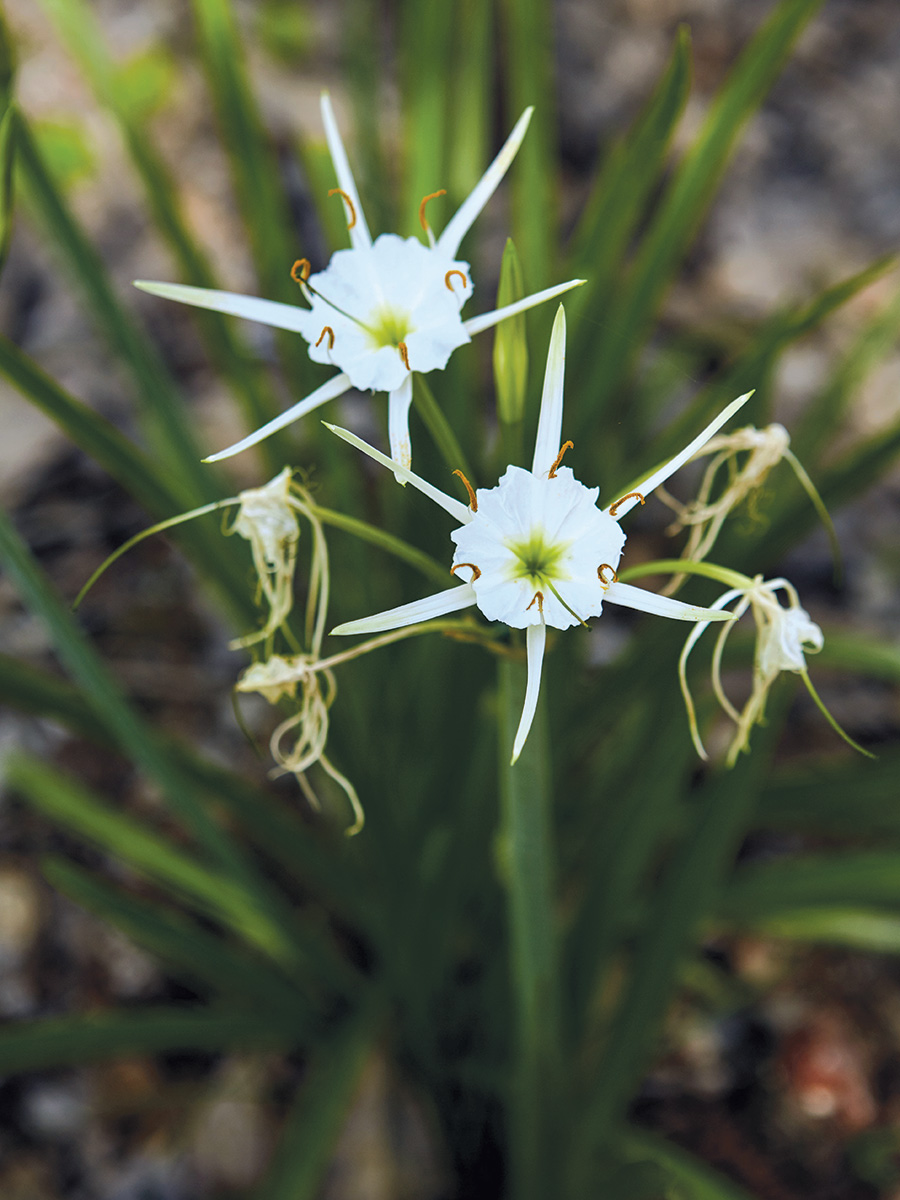
Native plants such as Texas spiderlilies (Hymenocallis liriosme) are right at home in a flood plain. PHOTO Nathan Lindstrom
After the damage, their main goal was clearing trails and making everything safe so they could open the park (which is free to visit) as quickly as possible. “It’s hard … when your building floods, and the park’s underwater, and the trails are mucked up,” says Abernathy, “but I also know that’s why we’re here.” He and others at Jesse H. Jones want to be available to their community, to offer programs and a pleasant place to walk, fish, bird and just be in nature.
Abernathy knows firsthand the benefit of having the park to come to — even in its post-flood state. He, like many, was experiencing chaos at home as well; he had 22 inches of water in his house and said coming to work helped him cope.
Development on the west side of Houston is “just exploding,” says Abernathy, and everything that runs off those largely impermeable surfaces heads downstream toward them. But Harris County is working to acquire land along Spring Creek through the entirety of Precinct 4.
It’s an effort to turn the 12-mile Spring Creek Greenway into a 40-mile trail system and natural corridor. Abernathy says the greenway will be “awesome for recreation and resources” but — even better — it will act as a “giant flood plain buffer.” And that makes him hopeful for the future, which is crucial. He says you’d go crazy if you focused on recovery 100 percent of the time.
THE BIRD SANCTUARY
EDITH L. MOORE NATURE SANCTUARY and the Power of Participation
By the time Bethany Foshée has finished walking the West Bank Trail at Houston Audubon’s Edith L. Moore Nature Sanctuary, she has an armful of trash: candy wrappers, plastic bags, wire, random detritus. “We were just painted with plastic bags and Styrofoam,” after Harvey, she says, “and large trash like furniture and car parts and construction debris.”
The 18-acre sanctuary is tucked discretely into a highly residential area near Houston’s CityCentre development. Ironically, it was originally meant to be a bucolic escape from the city for its namesake and her husband; now, Houston has completely engulfed the property. “People are funny,” says Foshée, who is sanctuary manager and docent programs coordinator. “They’ll go, ‘Wow, how did you get here in the middle of all our neighborhoods?’ Actually we were here first.”
The thing we’re experiencing now,” she says, “a lot of people call them ‘McMansions’: huge houses that take up the entire lot,” so there just isn’t as much green space. “We used to have a cushion of backyards on our border; now it’s walls of houses 4 feet away.” And Houston Audubon’s urban sanctuaries did take “the biggest hit” according to Conservation Director Richard Gibbons, Ph.D. “The coastal sanctuaries were particularly resilient,” he wrote in a post-Harvey blog update, which was what he expected. Gibbons describes coastal ecosystems as able to “flourish in the face of dynamic weather events.”
Despite the city pressing in, Foshée says “the forest is rebounding really quickly,” noting that erosion along Rummel Creek, which runs through the property, and trail degradation were their biggest issues. The first things to grow back were vines, including greenbriar (Smilax spp.) and trumpet vine (Campsis radicans).
One of the most amazing things to her was the fact that a lot of neighboring families whose own properties were flooded … came over to help.
You can hear the fondness in her voice when she talks about the sanctuary, which is free to visit and home to Houston Audubon’s headquarters. “We have some favorite trees,” she says, pointing out their only black cherry (Prunus serotina), which has a deep gouge in its bark from a floating bridge slamming into it — a hurricane scar. Foshée refers to the trees with the pronoun “she.” “Let’s see how she’s doing,” she says when approaching one of the sanctuary’s two toothache trees (Zanthoxylum clava-herculis). “She split in the storm, because she’s just long and spindly.” (The tree is currently splintered but their arborist isn’t very hopeful.)
As a bird sanctuary, they are obviously conscious of wildlife as well. “When the storm hit, it was that in-between time when summer residents are done breeding and winter migrants are going to come in,” says Foshée of their bird populations. But she did think winter migrants (who, of course, were coming in from elsewhere) seemed fine.
Amphibians and reptiles took the biggest hit. “They literally seem to have been washed away,” she says. “We normally have healthy populations of hognose snakes, nonvenomous water snakes, ribbon snakes, and they … have been gone since the storm.” Because the sanctuary is an “island of habitat” surrounded on all sides by urbanization, she wonders if those species will have to be reintroduced.
People came back on their own. “We’re a restorative space,” says Foshée. “On the weekends, [it’s] pretty busy with people who’ve been working in cubicles all week.” At a September workday just after the storm, they had more than 100 volunteers (compared to 30 or 40 on a typical Saturday) help demolish bridges that were ruined, collect trash, clear debris from trails, create temporary trails and lay caliche. Two volunteers brought a canoe and a chainsaw and went to work ferrying trash up the banks of the creek.
One of the most amazing things to her was the fact that a lot of neighboring families whose own properties were flooded, who were displaced and living in hotels, came over to help. “They said it felt so good to do something positive during that incredibly frustrating time when everyone’s hands were tied while they waited around for insurance adjusters. We had a family who demoed [a bridge],” says Foshée, “two little boys and mom and dad … with sledgehammers, and they were going after it.” They said it was like therapy, to be able to help a place they care about in their flooded community — and take their anger out on something.
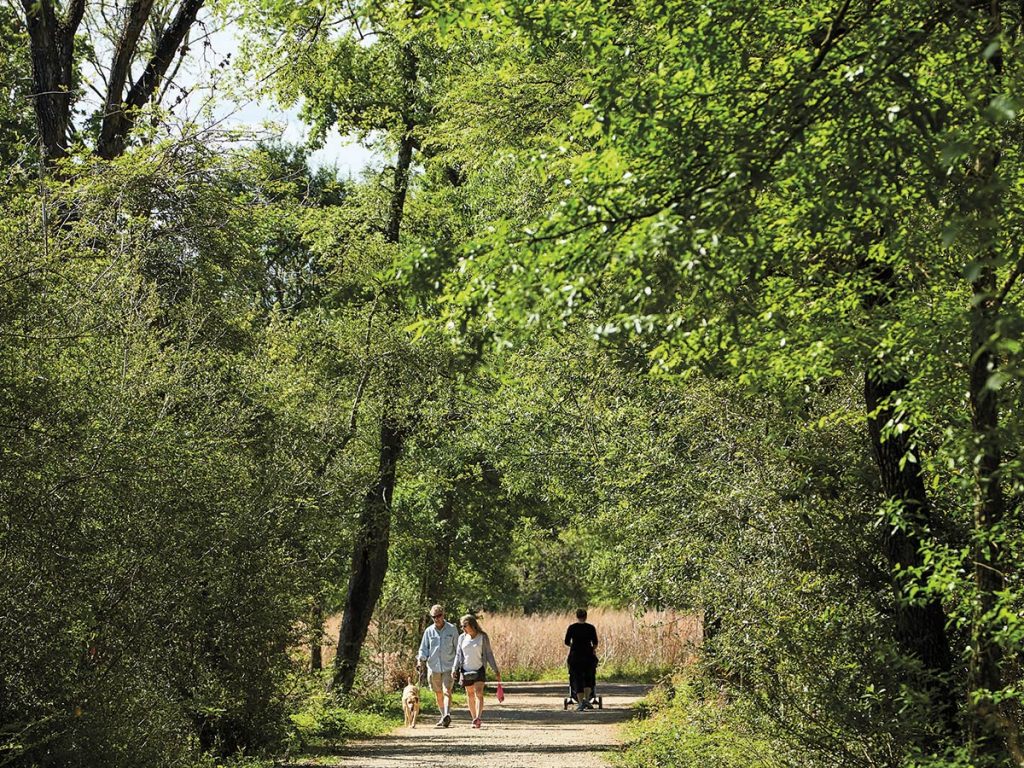
A mix of woodland and prairie ecosystems helped Houston Arboretum fare well during and after Hurricane Harvey. PHOTO Nathan Lindstrom
THE ARBORETUM
HOUSTON ARBORETUM and the Importance of Opening Up
Emily Manderson knows the importance of opening up — not in a spill-the-beans personal sense, but environmentally. As conservation director at Houston Arboretum & Nature Center, which didn’t experience much damage due to Hurricane Harvey, she has witnessed the power of open landscapes firsthand. “Open” meaning prairies, grasslands and savannas, which are actually covered in herbaceous plants but seem open because they lack an abundance of what arboreta are known for: trees.
The devastation caused by Hurricane Ike in 2008 made the arboretum, through its master plan process, realize that the site was actually too woody. Their entire understory had been taken over by invasive species (primarily Ligustrum spp.). To eradicate the invasives, they are now mimicking what natural fires would do by clearing out their forest’s understory and making room for grasses and forbs. “Immediately there was more light, wind and pollinator activity,” says Manderson.
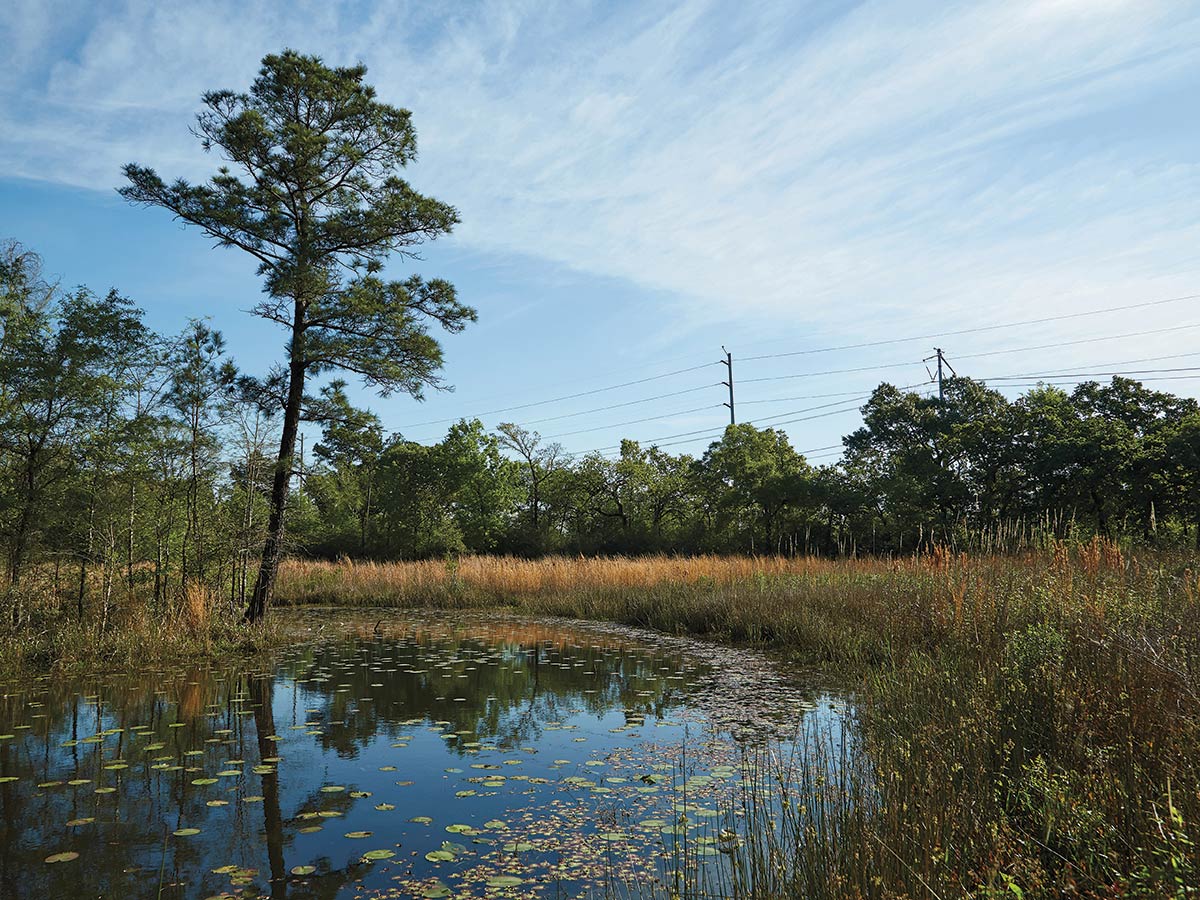
Prairies dotted with trees and ponds give rainwater a place to pool and help it absorb into the ground. PHOTO Nathan Lindstrom
“The silver lining of Hurricane Ike,” she explains, is that it “highlighted the vulnerability of the site and the need for more proactive management.” The arboretum, as well as Memorial Park (of which the arboretum is part), lost over 50 percent of its tree canopy due to Ike and the corresponding drought. “It became evident that the majority of tree mortality occurred in areas that were historically prairie and savanna ecosystems,” Manderson reports.
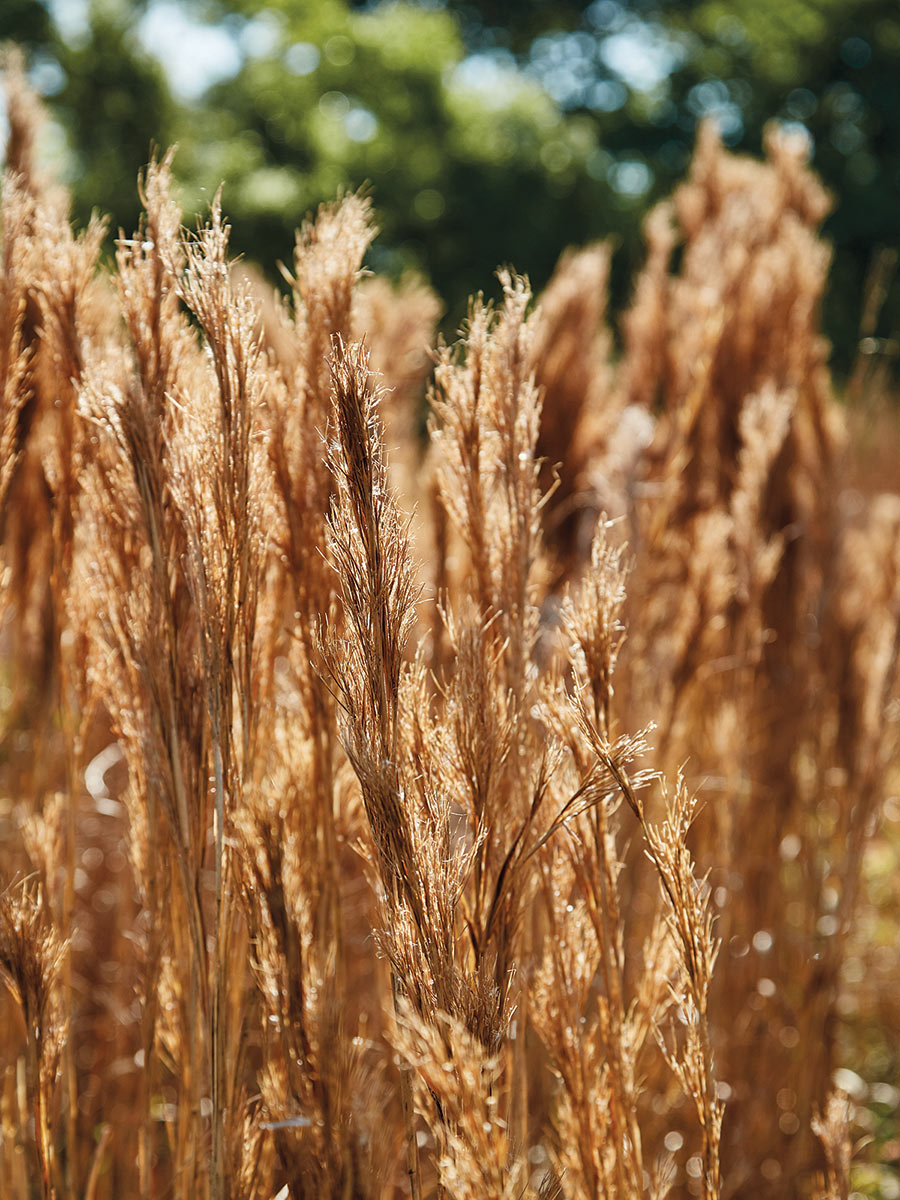
Native grasses such as bushy bluestem (Andropogon glomeratus) have extensive, deep root systems that drink up rainwater and prevent erosion. PHOTO Nathan Lindstrom
Now, there are more of those ecosystems at the arboretum, and Manderson sings their praises repeatedly when discussing the site’s resilience in the face of Harvey. “Wetland, prairie and savanna ecosystems are excellent at holding and infiltrating water,” she says, likening them to big green sponges. And the arboretum’s well-established prairie infiltrated a significant amount of water during the flooding; Manderson says there was “ponding for about a week, but trails soon were dry and the grasses and flowers in general looked happy and refreshed.”
Of course, there are still trees. The landscape is simply more diverse now — which is how it was meant to be. Manderson says the site has “an undulating topography” that’s typical of Gulf Coast prairies, “with subtle height elevations and depressions referred to as pimples and dimples.” It’s a working combination: Pimples are sandier and more conducive to tree growth while dimples have higher clay content and are dominated by grasses.
In their woodland areas, Manderson says they’ve seen the arrival of native plants such as American beautyberry (Callicarpa americana), passionflower (Passiflora spp.) and dwarf sundew (Drosera brevifolia) in place of invasives. These little rays of hope — as flowers often are — are just some of what she calls the “many indications that we are pushing the ecosystems in the right direction.”
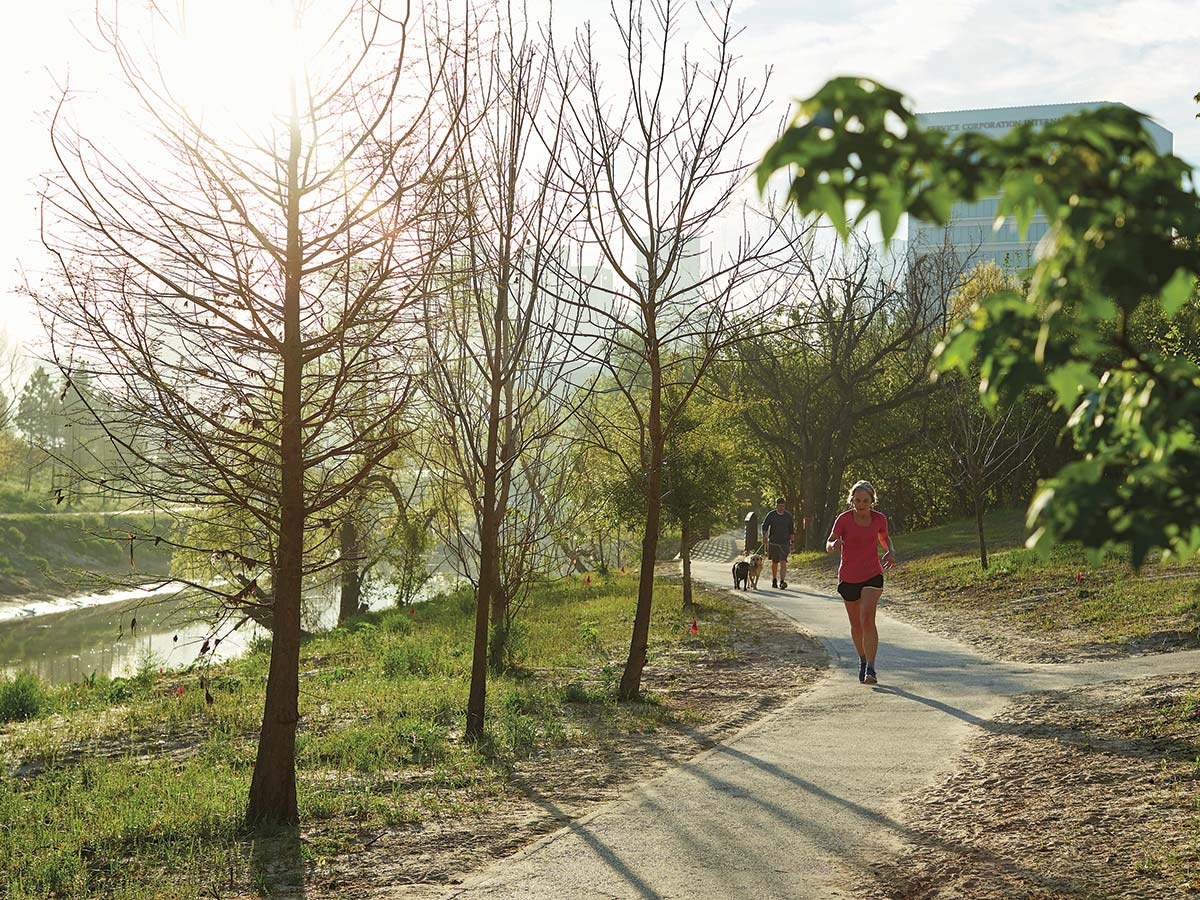
Buffalo Bayou Park is cherished by Houston residents as a place to exercise, relax and be in nature. Even massive erosion and silt deposits after the hurricane couldn’t keep people away. PHOTO Nathan Lindstrom
THE URBAN GREEN SPACE
BUFFALO BAYOU PARK and Going Greener
History is written in the trees of Buffalo Bayou Park in downtown Houston. It’s also written along the banks, scored into hillsides and wedged under Memorial Drive. The story is told by trash clinging to high branches, waving like ragged flags in the breeze; silt in hulking mounds where it’s been collected or swept into permanent impressions of running water; tree trunks lying horizontal on the ground or stuck under bridges where they’ve been lifted by high water and left there — nonsensical, out-of-place things; and blank space where there once were plants.
Even in late January, five months after the storm, Harvey’s destruction was apparent in Buffalo Bayou Park (the section of Buffalo Bayou between Sabine Street and Shepherd Drive, specifically). Still, it was busy with runners, bikers, people and dogs walking, picnickers and skateboarders — a testament to the value of green space in cities. This space’s palette is leaning more toward brown and gray than green these days, but, according to Anne Olson, executive director of the Buffalo Bayou Partnership, this green-brown-gray space was flush with activity within days of Hurricane Harvey. “Houstonians were out and about using the park,” she says. “The large amounts of sediment did not deter them.”
Harvey didn’t just paint the scene taupe; the flooding it caused wiped out an estimated 400 trees along the banks due to erosion and silt deposits. (Trees For Houston, a nonprofit dedicated to planting and protecting trees, is donating 150 redbuds, Cercis canadensis, to help replenish the landscape.) Olson says the park was planted in phases: “Where the trees had been planted earlier in the project, the banks fared very well” — not so much in places where trees hadn’t had time to get established.
On a brighter note, native grasses and palmettos (Sabal spp.) near Lost Lake, at the west end of the park, appeared healthy and undamaged, and Communications Coordinator Jessica McFall describes the park’s four perennial gardens as “virtually unharmed.” They are situated along the park’s highest banks, however, where fast-moving water and silt deposition weren’t as extreme. Olson calls it a “tale of two parks” in her post-hurricane web update, writing that the upper portion “fared extremely well with very little damage,while the lower areas were greatly impacted.”
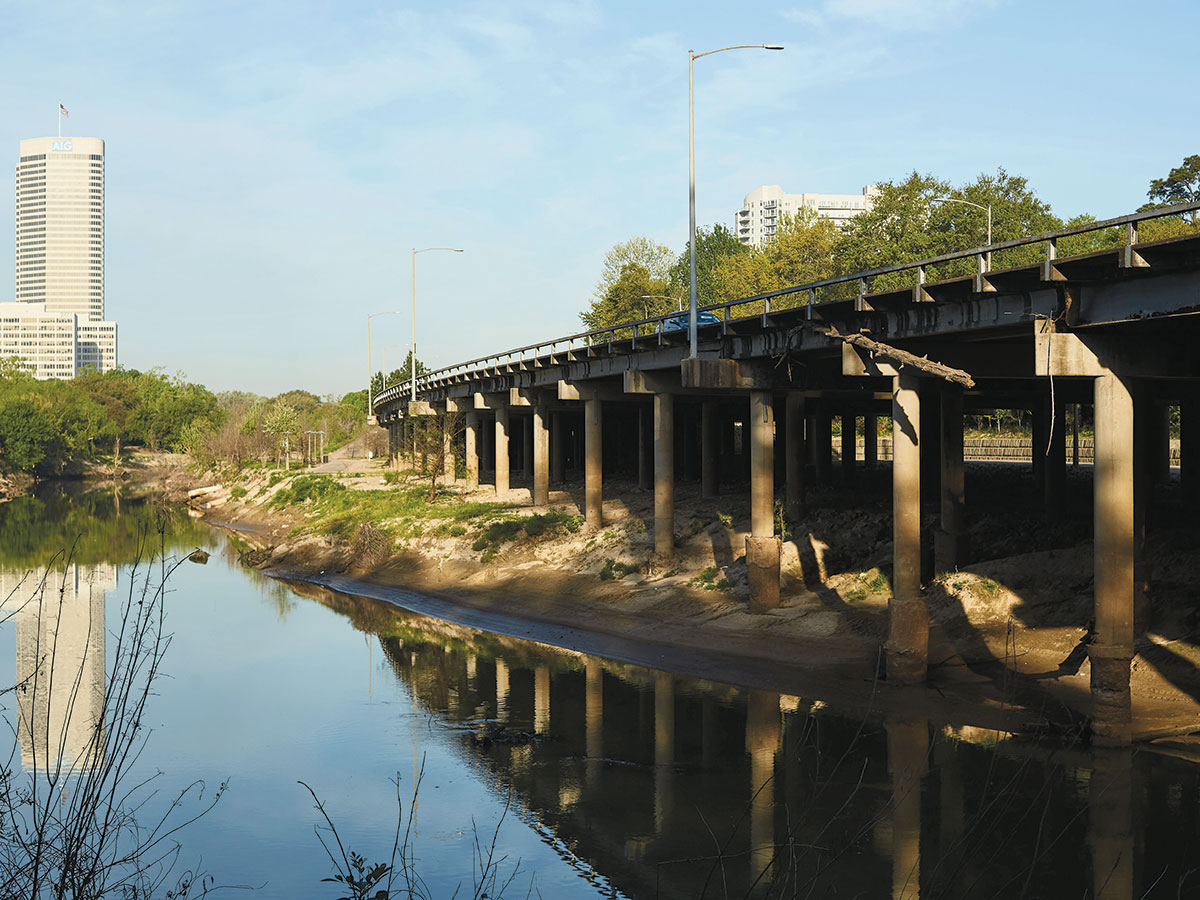
Floodwater in Buffalo Bayou reached high enough to wedge an entire tree trunk under adjacent Memorial Drive, creating an odd sight after the storm. PHOTO Nathan Lindstrom
She mentions bald cypress as particularly resilient and says willow stakes planted by the Harris County Flood Control District prior to the storm “performed very well.” (Stakes are dormant, branchless woody cuttings often employed for erosion control and site restoration.) The partnership is doing further research into erosion-control techniques and may plant more native riparian species such as eastern gamagrass (Tripsacum dactyloides) going forward.
But it’s not like they didn’t think about flooding in the first place; after all, this is Houston. The park’s master plan (by landscape architecture rm SWA Group) reduced lawn coverage by 50 percent and incorporated wildflowers and native grasses with robust root systems with inevitable flooding in mind. But after Harvey’s catastrophic rainfall, it simply wasn’t enough.
Like all waterside places, really, Olsen says Buffalo Bayou Park is “very dependent on what happens upstream” — where, in Houston, breakneck development and impermeable surfaces abound. The severity of Hurricane Harvey meant water was being released from upstream reservoirs for approximately six weeks, a situation Olson calls “very unusual,” adding, “this long period of water releases exacerbated the erosion.”
Given the city’s location and history, it’s safe to say Houston will flood again. When asked what she thinks needs to be done to address that reality moving forward, Olson’s answer is simple, and it matches the sentiments of everyone we spoke with: “Increased green space along our bayous is a must.”
This was meant to be a story about plants. But it was destined to be about people too. Because people — especially people in cities — need plants. Plants don’t necessarily need us if they are in the right place. They grow on their own; wildlife comes to them, sun comes to them, water comes to them (admittedly, sometimes way too much water). But people need plants, so this is also their story. It’s the story of people who appreciate plants and natural spaces in their cities and who care enough about plants to work with them, to focus their lives on them, to make sure they are a part of our urban fabric — and to rebuild with them again and again.

